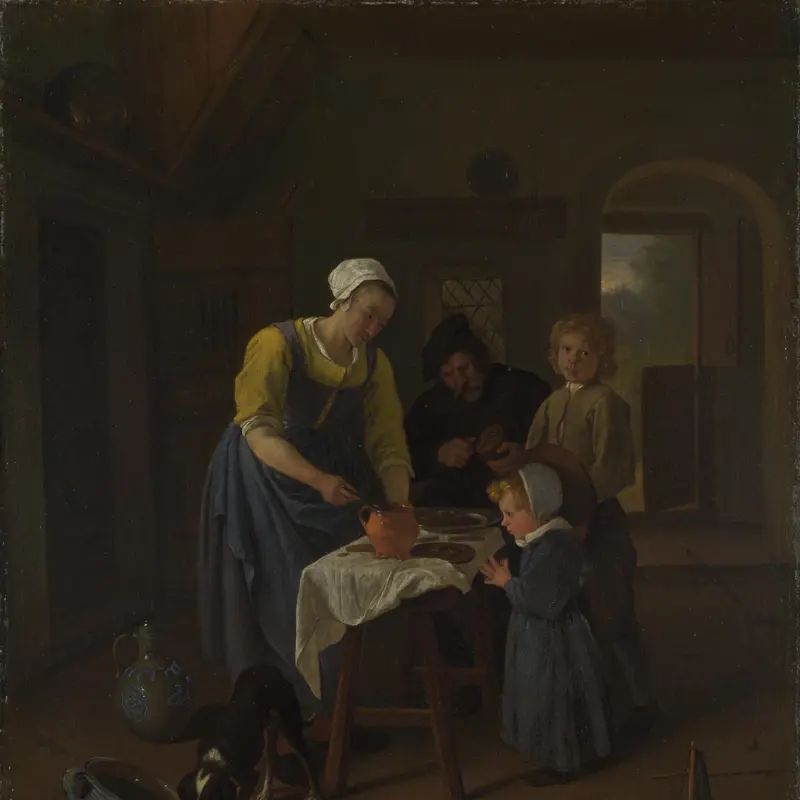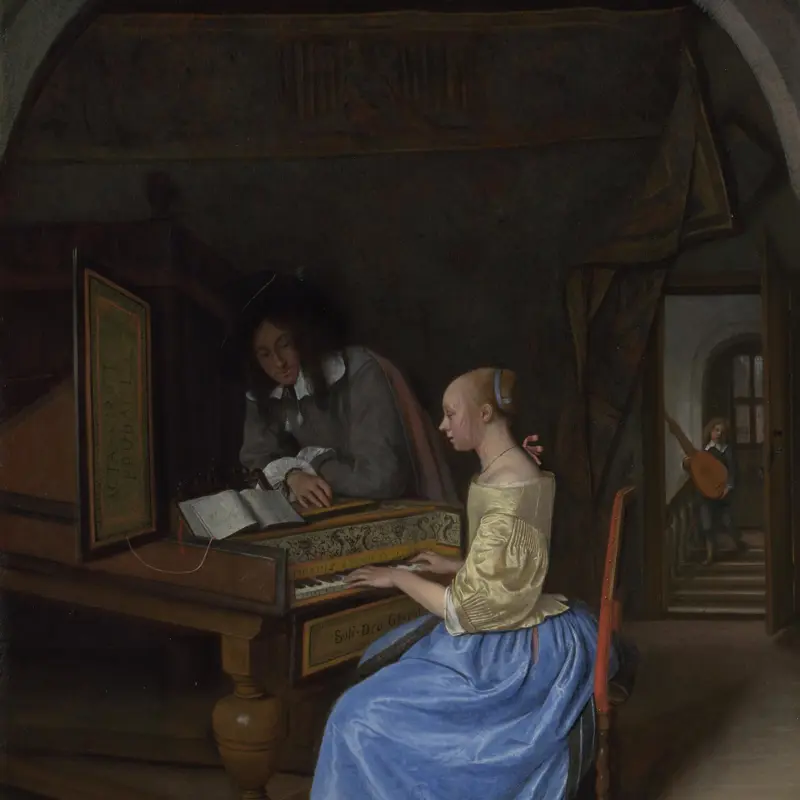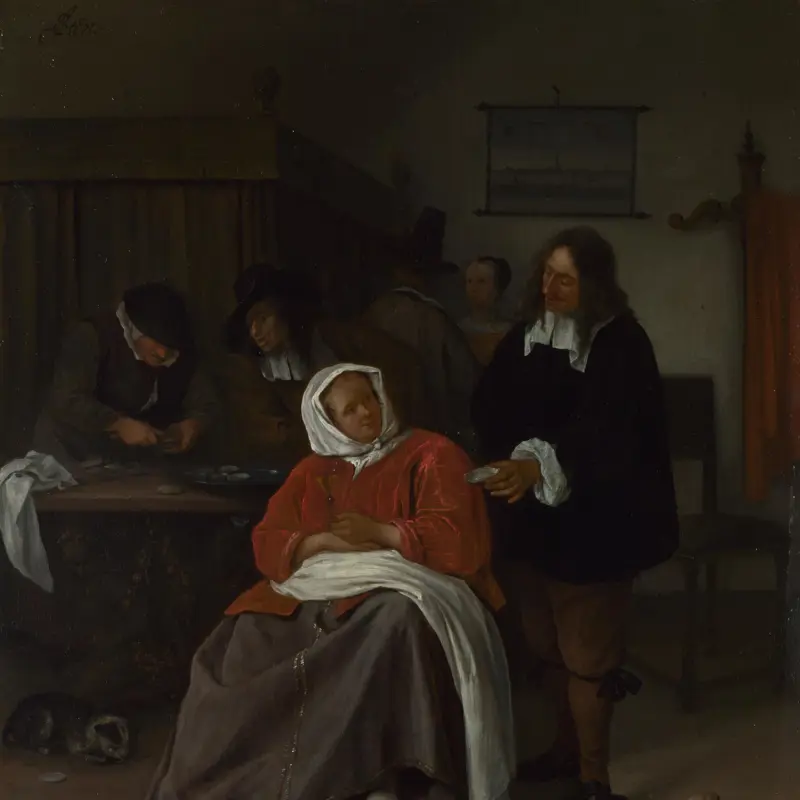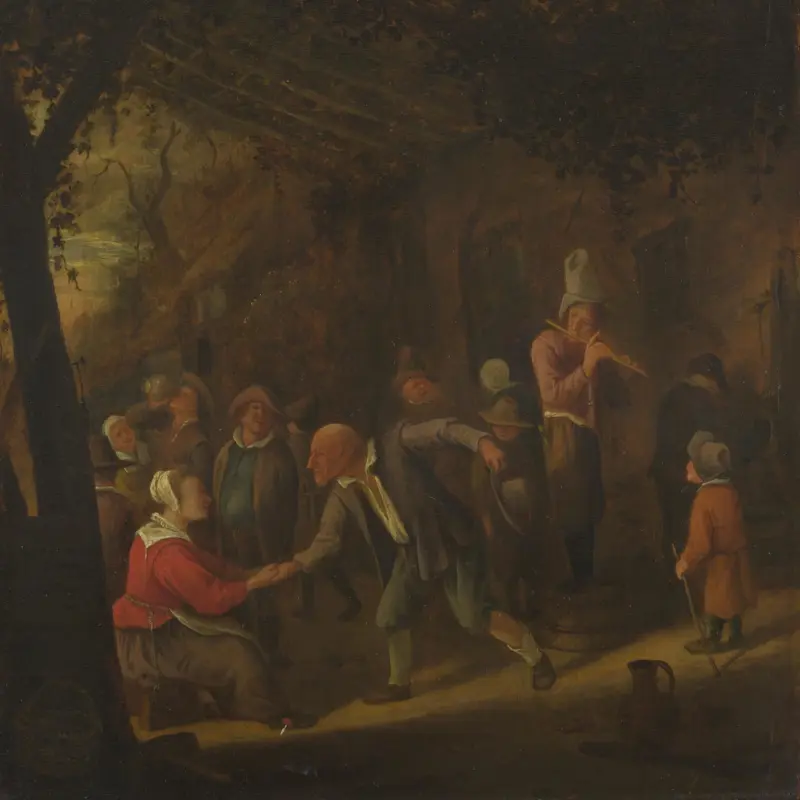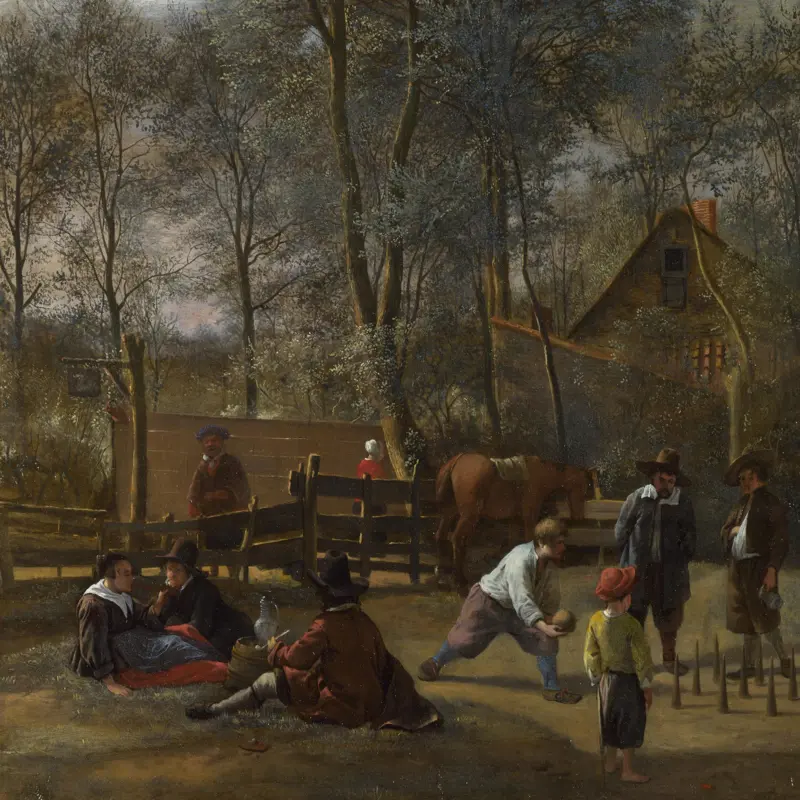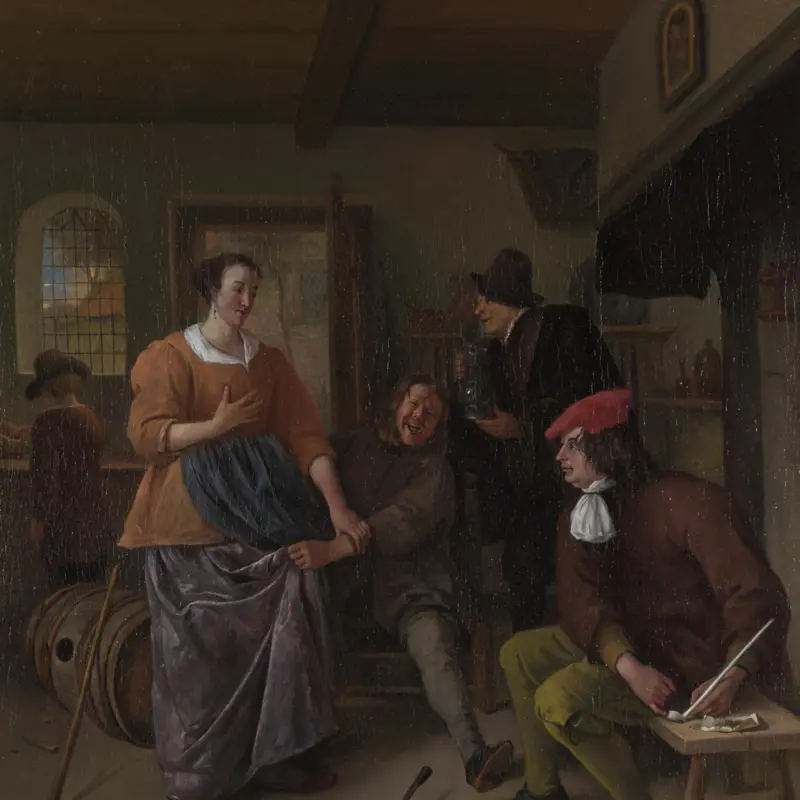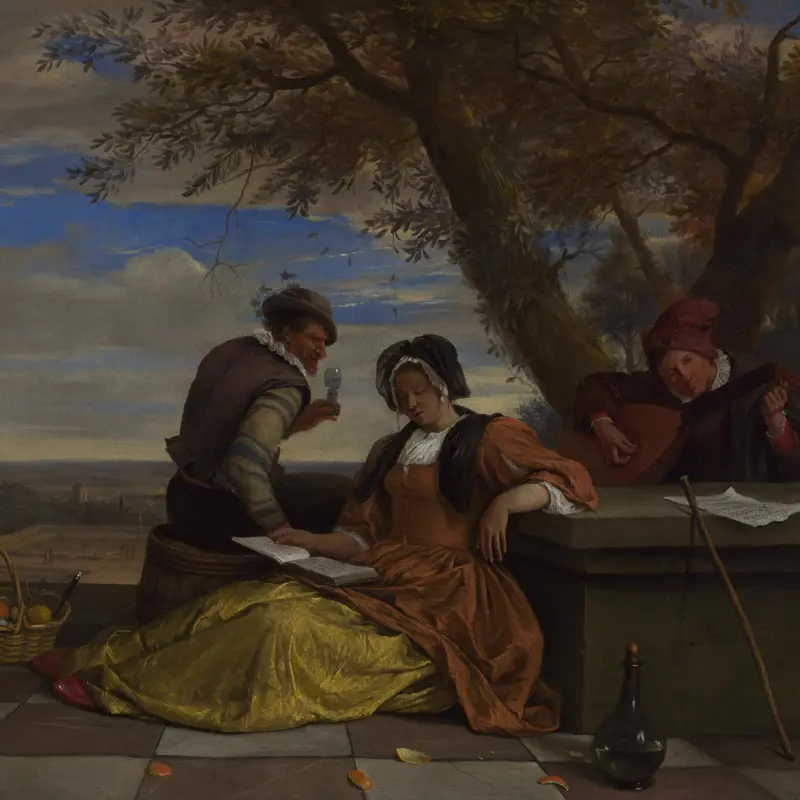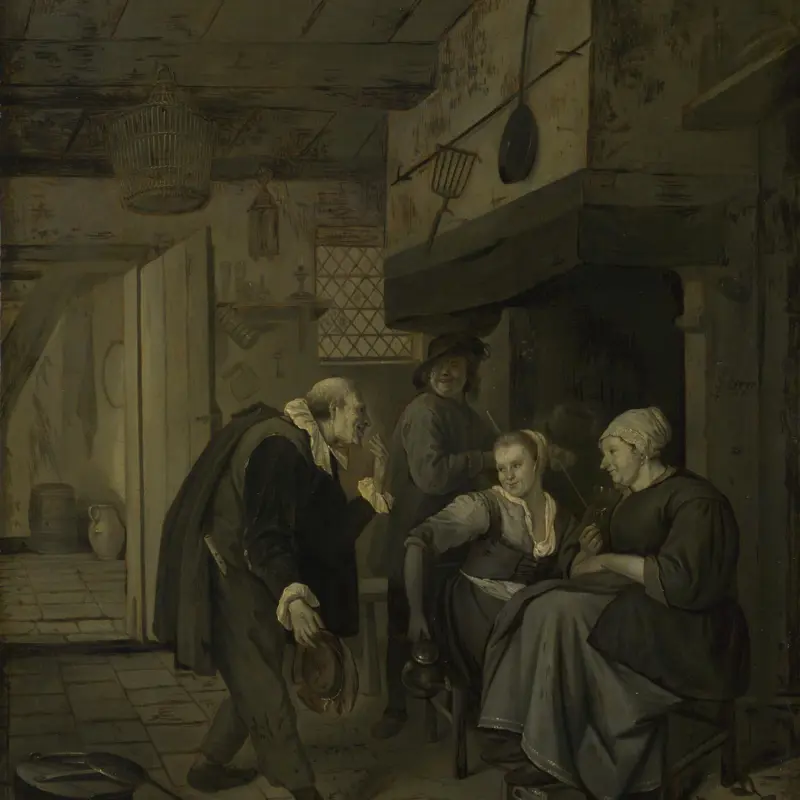Jan Steen, 'The Effects of Intemperance', about 1663-5
About the work
Overview
Propriety, order and temperance were important virtues in Dutch Calvinist society in the seventeenth century. People admired hard work and disapproved of wantonness. But they also liked a good laugh and the way that Jan Steen could make moralising entertaining.
Some of his jokes are immediately clear. We can see that this is a household where the children and servants are taking over. They are feeding their lunch to the cat, wine to a parrot and roses to the pig, while a small boy reaches into the purse of the sleeping woman. She is the mother of the household, responsible for the well-being of her family. Intoxicated with tobacco and wine, implies Steen, she has neglected her duties. As a result her children run riot, and in the garden beyond a man – perhaps her husband – seduces the young woman who is sitting in his lap.
Key facts
Details
Provenance
Additional information
Text extracted from the ‘Provenance’ section of the catalogue entry in Neil MacLaren, revised and expanded by Christopher Brown, ‘National Gallery Catalogues: The Dutch School: 1600–1900’, London 1991; for further information, see the full catalogue entry.
Exhibition history
-
2020SinThe National Gallery (London)7 October 2020 - 3 January 2021
-
2022Sin (National Touring Exhibition)Perth Museum and Art Gallery18 June 2022 - 25 September 2022York Museums Trust7 October 2022 - 22 January 2023The Arc (Hampshire Cultural Trust)24 February 2023 - 14 May 2023The Auckland Project17 June 2023 - 1 October 2023
Bibliography
-
1838G.F. Waagen, Works of Art and Artists in England, trans. H. Lloyd, vol. 2, London 1838
-
1856T. van Westrheene, Jan Steen, La Haye 1856
-
1907C. Hofstede de Groot, Catalogue Raisonné of the Works of the Most Eminent Dutch Painters of the Seventeenth Century, 10 vols, London 1907
-
1907C. Hofstede de Groot, Catalogue Raisonné of the Works of the Most Eminent Dutch Painters of the Seventeenth Century, 10 vols, London 1907
-
1927A. Bredius, Jan Steen, Amsterdam 1927
-
1929R.C. Witt, Exhibition of Dutch Art 1450-1900 (exh. cat. Royal Academy of Arts, 1929), London 1929
-
1938Catalogue of the Exhibition of 17th Century Art in Europe, London 1938
-
1952Royal Academy of Arts, Dutch Pictures 1450-1750 (exh. cat. Royal Academy of Arts, 22 November 1952- 1 March 1953), London 1952
-
1953'Worthy of Study: Sir Gerald Kelly's [president of RA] Choice of Dutch Paintings', Illustrated London News, 1953
-
1958S.J.M. van Nassau, Jan Steen (exh. cat. Mauritshuis, 20 December 1958 - 15 February 1959), The Hague 1958
-
1978The National Gallery, The National Gallery: July 1975 - December 1977, London 1978
-
1983C. Brown, 'Rubens' Watering Place: An Examination of His Landscape Technique', Ringling Museum of Art Journal, 1983, pp. 130-49
-
1983M.F. Durantini, The Child in Seventeenth-Century Dutch Painting, Ann Arbor 1983
-
1986M. Levey, Director's Choice: Selected Acquisitions 1973-1986: An Exhibition to mark the Retirement of Sir Michael Levey as Director of the National Gallery (exh. cat. The National Gallery, 17 December 1986 - 15 February 1987), London 1986
-
1991Maclaren, Neil, revised by Christopher Brown, National Gallery Catalogues: The Dutch School, 1600-1900, 2nd edn (revised and expanded), 2 vols, London 1991
-
1991C. Wiggins and G. Greer, Paula Rego: Tales from the National Gallery (exh. cat. Plymouth City Museum and Art Gallery, 25 April - 1 June 1991; Middlesbrough Art Gallery, 15 June - 20 July 1991; Whitworth Art Gallery, 3 August - 25 September 1991; Cooper Art Gallery, 22 October - 30 November 1991), Plymouth 1991
-
1993J. Held, Sozialgeschichte der Malerei vom Spätmittelalter bis ins 20. Jahrhundert, Köln 1993
-
1995H.P. Chapman, 'Jan Steen as Family Man: Self-Portrayal as an Experiential Mode of Painting', Nederlands Kunsthistorisch Jaarboek, 1995, pp. 368-93
-
1996H.P. Chapman, W.T. Kloek and A.K. Wheelock, Jan Steen: Painter and Storyteller (exh. cat. National Gallery of Art, Washington, 28 April - 18 August 1996; Rijksmuseum, 21 September 1996 - 12 January 1997), Washington 1996
-
1997E. Langmuir, Allegory, London 1997
-
1997M. Westermann, The Amusements of Jan Steen: Comic Painting in the Seventeenth Century, Zwolle 1997
-
1997C. Brown, 'H. Perry Chapman, Wouter Th. Kloek and Arthur K. Wheelock Jr., exh cat. Jan Steen: Painter and Story-Teller', Simiolus, XXV/1, 1997, pp. 81-4
-
2001
C. Baker and T. Henry, The National Gallery: Complete Illustrated Catalogue, London 2001
About this record
If you know more about this work or have spotted an error, please contact us. Please note that exhibition histories are listed from 2009 onwards. Bibliographies may not be complete; more comprehensive information is available in the National Gallery Library.


